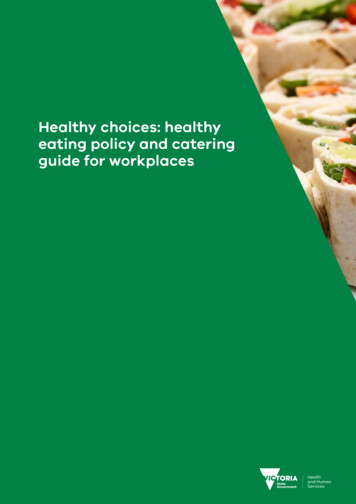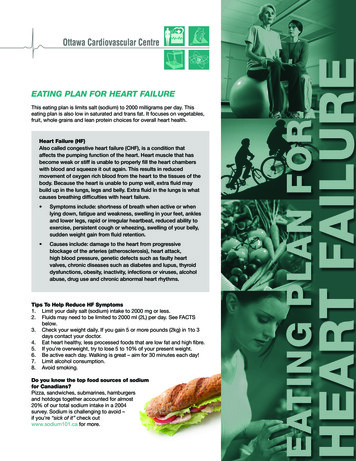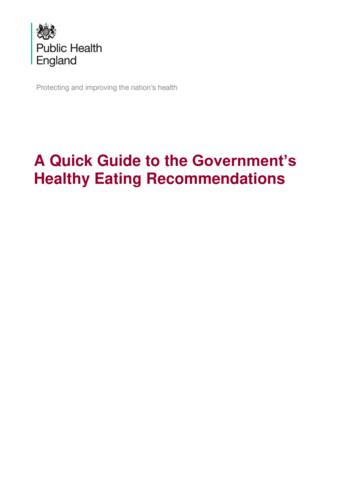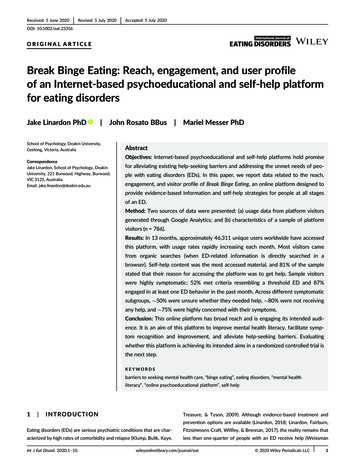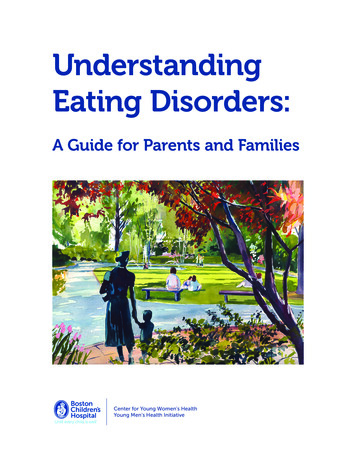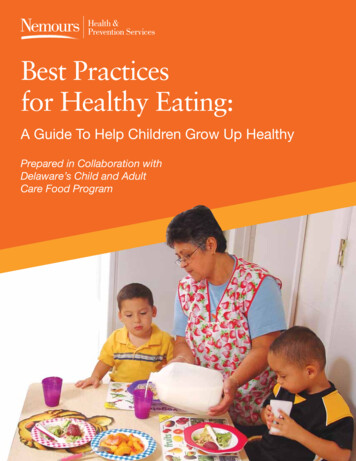
Transcription
Best Practicesfor Healthy Eating:A Guide To Help Children Grow Up HealthyPrepared in Collaboration withDelaware’s Child and AdultCare Food Program
AcknowledgementNemours Health and Prevention Services would like to thankBeth Wetherbee for her support and contribution in creatingthis guide. We would also like to thank Sara Benjamin,PhD, MPH, RD; Tracy Fox, MPH, RD; Barbara Polhamous,PhD; and Leann Birch, PhD for reviewing and providingvaluable input and Tammy Beeson for graphic design.NHPS team members contributing to this guide included:Elizabeth Walker, MS; Fanilda Shaw, MS; Denise Driscoll,MS; Mary Trotter, MS, RD; Dorothy Onn, MSW; DanielIsett, BA (design), Andrea Duff, BFA; Kristen Wan, MS;Mary Neal Jones, MS; and Karyl Rattay, MD, MS.This guide was created using recommendations fromthe following sources: T he National Alliance on Nutrition and ActivityModel Local School Wellness Policies (2006) I nstitute of Medicine School FoodRecommendations (2007) C hild and Adult Care Food ProgramGuidelines (2007) A merican Academy of PediatricsRecommendations for Milk, Juice,and Breastfeeding.For more detailed references, contactinformation, or to learn about our Campaignto Make Delaware’s Kids the Healthiest in theNation, please visit www.growuphealthy.org.Version 2Copyright 2008 The Nemours Foundation. All rights reserved.3Best Practices for Healthy Eating
HealthyHabitsStartEarly!Together with Delaware’s Child and AdultCare Food Program (CACFP), Nemours Healthand Prevention Services (NHPS) is providingthis best practice nutrition guide to help youngchildren in our state develop healthy eatinghabits early in life.In Delaware, approximately 37% of our childrenare overweight or obese and are at high riskfor developing serious health problems such ashypertension and type 2 diabetes. NHPS is joiningwith Delaware’s CACFP to develop programsthat translate current research into best practicesfor our children.Children who are given healthy food optionsduring early childhood are more likely to continuehealthy eating habits when they are older. You andyour program play an important part in introducingyour children to healthy food, by both providingnutritious food and teaching children how to makehealthy food choices. By sharing information withfamilies, you can work with them as partners tosupport healthy children.The purpose of this guide is to provide you withinformation on how to help the children in your caregrow up healthy. In this guide you will find: H ealthy food guidelines for beverages,fruits and vegetables, milk, meats and meatalternates, and grains and breads. ortion sizes that are based on the PCACFP reimbursable meal guidelines. Rationale for the recommendations. Sample policies that you can use in yourprogram and with families to support your work.A Guide To Help Children Grow Up Healthy3
Hungry or Full?Most infants and young toddlers can figure out when they are full and stop eating if permitted. It’samazing to watch young children over the course of the week; they eat as much as they need togrow! However, as the toddler becomes a preschooler, we place more food on the plate and he canlose that sense of when to stop, and continues eating even when he is not as hungry.You can help children eat just the right amount by following these easy strategies:For infants Look for hunger cues. Infants have different ways of showing theyare hungry but common hunger cues include rooting or trying toput a fist in their mouth. When the infant cries, look to see what else could be botheringher before immediately feeding. An infant who cries may not behungry. A need for sleep, affection or a diaper change may alsobe the cause. When the infant becomes distracted, and sucking stops orbecomes less frequent, then take the bottle out and see if hestill roots for it. The infant could just be using the bottle as apacifier after he has fulfilled his hunger needs. Look for milk running out of the infant's mouth. An infantmay let the bottle stay in her mouth even after she is full. It is not necessary to finish off a bottle, container of food or food on the plate. Even when there isan ounce left, if an infant is full, let him stop eating. If you are worried about wasting breast milkor iron-fortified infant formula, give smaller amounts and add more if the infant is still hungry.For toddlers and older children Little tummies need small portions. Just like adults, when there is a large amount of food onthe plate, children will eat it. Therefore, start small and ask them if they are hungry beforeserving or allowing second servings. This will also reduce food waste and save money! Serve family style — children will learn to put the right amount on their plates from the start. Create a positive eating environment by listening when a child says she is full. Discourage the“clean your plate” habit. A toddler may not say she is full, but she may start playing, becomedistracted, shake her head “no,” close her mouth and refuse to finish the food on her plate. Sit with the children and let them see you eat when you are hungry and stop eating when youare full, even if there is food on your plate. Explain what you are doing. Complaints of being hungry, especially when a child has just eaten, may be due to othertriggers such as boredom, TV advertising or seeing another person eating. reate a positive eating environment byClistening when a child says he is full.4Best Practices for Healthy Eating
What about those “picky eaters”?It is natural for children to be cautious with new foods. We know that for young children, it can take 10 to 15times of actually putting the food in their mouths before they will come to like it. We also know that somechildren are especially cautious about trying new foods, while others use food as a way to be in control.Use these strategies to create a positive environment and minimize the struggles for trying new foods.For infants Don’t be discouraged by a frown. Infants naturally prefer salty and sweet tastes, so for some fruits andvegetables, it may take 10 to 15 tries for a child to accept the new food. Don’t give up. When offering a new food, serve the infant a food they are familiar with and like. You could tryalternating bites between the new food and the familiar food.For toddlers and older children Create a routine that everyone should try and taste new foods offered at your center. It’s the rule atyour table. However, do not force them to finish more than they want. Put a very small portion on the plate to try (like two peas). Youngchildren may be concerned that they won’t like the new food,so help them by putting a small amount on their plates—it looksless overwhelming. Always offer healthy foods or create a policy that requiresparents to provide healthy foods in lunches and snacks—especially ensuring that parents provide plenty of fruits andvegetables. Avoid rewarding good behavior or a clean plate with foods ofany kind. Especially avoid forcing a child to finish the “healthyfoods” to get to their dessert or sweets—this can make thehealthy food seem like punishment and force the child to eatwhen they are full. Offer desserts rarely so children do not expect them at everymeal. When children come to expect dessert, they may not eatthe healthier foods or they may see desserts as a reward foreating healthy food. By not having dessert as a regular option,you minimize this struggle. When introducing a new food, make it a game or lesson. Again, it can take up to 10 to 15 tries fora child to accept a new food. Try offering the new food outside the meal time. You can make it aclassroom lesson and then have children who are interested in trying the new food take a taste andshare their perceptions. This creates a desirability to try the new food.A Guide To Help Children Grow Up Healthy5
Special note on breastfeedingand introducing solidsThe American Academy of Pediatrics (AAP)recommends exclusive consumption ofbreast milk for at least the first four to sixmonths of life. This is followed by the gradualintroduction of solid foods beginning at age4 to 6 months. Breastfeeding should stillcontinue until 12 months of age or longer.As a childcare provider, you cansupport breastfeeding by developingpolicies and practices to providebreast milk exclusively.Children under 4 to 6 months of ageshould be drinking breast milk oriron-fortified infant formula exclusively.6Best Practices for Healthy Eating
Introducing solids beginningat four to six months of ageSigns that the infant may be developmentallyready for solids will most likely appearbetween 4 and 6 months of age: absence of tongue thrust reflex good neck and head control increased demand for breastfeeding thatcontinues for a few daysWhen solid foods are introduced, the AAPrecommends that single-ingredient foods begiven one at a time.Wait seven days between offering new foods,so that it will be easier to identify the food ifthe infant experiences an adverse reaction(allergy or intolerance).As new solid foods are being introduced, itis best to consult with the child’s parents (orlegal guardian) and/or pediatrician.A Guide To Help Children Grow Up Healthy7
BeverageGuidelines:Birth up to12 monthsTo prevent toothdecay and overfeedingdon’t let infants sleepwith a bottle or prop thebottle while feeding.AgeRecommendedBirth up to 4 Breast milk (preferred)months I ron-fortified infant formula4 up to 8months Breast milk (preferred) Iron-fortified infant formulaNot Recommended Other foods at this age F ood or drink other than breast milk and/or iron-fortifiedinfant formula in a bottle unless medically necessary ow’s milk or lactose-free milk or nutritionally-equivalent Cbeverages like soy or rice milk 1 00% fruit and vegetable juices (with no added sweeteners)until 12 months of age Breast milk (preferred)8 up to 12months Iron-fortified infant formula Water with no addedsweeteners Soft drinks Sports/energy drinks S ugary beverages including fruit-based drinks with addedsweeteners, sweetened iced teas, punch, etc. A rtificially sweetened beverages including diet soft drinks,teas, lemonade, etc. Caffeinated beverages8Best Practices for Healthy Eating
RationaleWhy is juice not recommended for infants until 12 months of age or older? W e recommend whole fruits and vegetables, rather than juice, for infantsduring the first year of life because they provide nutrients and fiber thatmay be lost in the processing of juice.Why should no food or drink other than breast milk or iron-fortified infantformula be served in the bottle? Food added to a bottle does not help infants sleep through the night. This practice deprives infants of the opportunity to learn to regulate theirfood intake. Bottle promotes tooth decay.Why are sugary beverages not recommended? S ports and soft drinks are high in calories and low in key nutrients. Breast milk or iron-fortified formula and water are the only beveragesrecommended for children during their first 12 months to meet theirnutrient needs. Consumption of sugary beverages is associated with:o Overweight or obesityo Calcium deficiency because sugary beverages displace milko Tooth decayPortion SizeWatch for hunger and fullness cues. Signs of hunger in infants may be:sucking noises or sucking on fist or fingers, fussiness, or crying.Signs of fullness may be: sealing the lips together, decreasing theamount of sucking, spitting out or refusing the nipple, pushing or turningaway from the breast or bottle.AgeItemBirthup to 4months Iron-fortifiedinfant formula Iron-fortifiedinfant formula Water with noadded sweeteners Breast milk (preferred)8 up to 12monthsSnacks Breast milk (preferred) Breast milk (preferred)4 up to 8monthsMeals Iron-fortifiedinfant formula Water with noadded sweeteners4-6 oz.Approximately4-8 oz.4-6 oz.Small amount can be given afterbreast milk or iron-fortified infantformula. Water can be used forpracticing cup use.Approximately6-8 oz.2-4 oz.Small amount can be given afterbreast milk or iron-fortified infantformulaSample policy supportfor program, staff, andfamily handbooksProgram and Staff B reastfeeding is encouraged andsupported for infants of breastfeedingmothers. If a mother wishes to breastfeed exclusively, the program will makeevery effort to provide breast milk to thechild and supplement only when breastmilk is gone. T o support children’s healthy eatinghabits, hunger and fullness cues will beobserved and supported. F ollowing the American Academyof Pediatrics recommendations, thisprogram will not serve any food or drinkother than breast milk and/or iron-fortifiedinfant formula in a bottle unless medicallynecessary. W e at (name of the program) arecommitted to our children’s health.We recognize the importance of the staffas positive role models for the children asthey learn to live healthy lives. Therefore,the staff will not drink soda and sugarybeverages in front of the children intheir care. W e at (name of the program) arecommitted to children’s nutrition andrecognize the importance of adultsas positive role models on children’sbehavior. Therefore, during functionsor meetings at the center, we will onlypermit water, milk, or 100% fruit juice tobe served.Families P roviding good nutrition for your child isa partnership. We serve healthy mealsand snacks in our program and ourstaff model healthy eating behaviorsthroughout the day. We ask for yoursupport by not packing any food or drinkother than breast milk and/or formula in abottle unless medically necessary.A Guide To Help Children Grow Up Healthy9
Fruit andVegetableGuidelines:Birth up to12 monthsAgeRecommendedBirth up to 4 Breast milk (preferred)months I ron-fortified infant formula A variety of different fruits and or vegetables may beoffered. All fruits and vegetables should be mashed,strained, or pureed to prevent choking. Fruits and vegetables should be served plain, withoutadded fat, honey, sugar, or salt at this age.4 up to 8months Some examples include:o Commercially prepared baby fruitso Commercially prepared baby vegetableso Fresh or frozen fruitso Fresh or frozen vegetableso Canned fruits (in their natural juices or water)o Canned vegetables with no added sodium A variety of different fruits and/or vegetables may beoffered. All fruits should be cooked if needed and/or cut into bitesize pieces to prevent choking.8 up to 12months All vegetables should be cut into bite-size pieces andcooked to prevent choking. Corn, specifically, should bepureed and cooked before serving. Fruits and vegetables should be served plain, with noadded fat, honey, sugar or salt. Some examples include:o Fresh or frozen fruitso Fresh or frozen vegetableso Canned fruits (in their natural juices or water)o Canned vegetables with no added sodium10Best Practices for Healthy EatingNot Recommended Other foods at this age A dded fat, honey, sugar, or saltto fruits and vegetables 1 00% fruit and vegetable juicesuntil 12 months of age F ruit-based drinks with addedsweeteners F ood or drink other than breast milkand/or formula in a bottle unlessmedically necessary re-mixed commercially prepared Pfruits with more than one food item P re-mixed commercially preparedvegetables with more than one fooditem Fried vegetables and fried fruits T he following fruits and vegetablesare a choking hazard to childrenunder 12 months:o Dried fruit and vegetableso Raw vegetableso C ooked or raw wholecorn kernelso H ard pieces of raw fruit suchas apple, pear, or melono W hole grapes, berries, cherries,melon balls, or cherry or grapetomatoes
RationaleWhy are fruits and vegetables important? T he Dietary Guidelines for Americans encourage consumption of avariety of fruits and vegetables daily. ruits and vegetables provide essential vitamins and minerals, Ffiber, and other substances that may protect against many chronicdiseases. They are high in fiber. They help children feel fuller longer. T hey provide children with the opportunity to learn about differenttextures, colors, and tastes. They help children potentially develop life-long healthy eating habits.Why no commercially prepared fruits and/or vegetables mixtures? Portions of the food components in the mixture are not specified. M ixture may contain a new food that the child has not tried and maycause an allergic reactionSample policy supportfor program, staff, andfamily handbooksProgram and Staff W e at (name of the program) support yourchild’s healthy food choices by:o G ently encouraging children to try fruitsand vegetables and giving positivereinforcement when they do.o R ole-modeling positive behaviors byeating fruits and vegetables in thepresence of the children.o Providing nutrition education. D uring celebrations and holiday parties, ourprogram will offer fruits and vegetables andother healthy foods.FamiliesPortion SizeWatch for hunger and fullness cues.AgeItemMeals4 up to 8months Fruits and/orvegetables0-3 Tbsp8 up to 12months Fruits and/orvegetables1-4 Tbsp P roviding good nutrition for your child is apartnership. We at (name of program) ask foryour support:o For packed lunches, please include fruitsand/or vegetables.o F or celebrations and holiday parties,please provide healthy foods (especiallyfruits and vegetables). An approved list ofage-appropriate foods will be provided.A Guide To Help Children Grow Up Healthy11
Meats andMeat AlternatesGuidelines:Birth up to12 monthsAgeRecommendedBirth up to 4 Breast milk (preferred)months I ron-fortified infant formulaNot Recommended Other foods at this age Breast milk4 up to 8months Iron-fortified formula Fruits Other foods at this age Vegetables Iron-fortified cereal Protein sources such as lean meat (beef,veal, and/or pork), skinless poultry (chicken,turkey), fish, cooked beans and peas(legumes),nut butters, eggs, yogurt andcheeses are recommended.8 up to 12months Meat poultry and fish should have no more than35% of calories from fat and no more than 10%of calories from saturated fat. (See sample foodlabel in Appendix). Nuts, nut butters and seedsare excluded from this fat restriction becausethe majority of their fat is unsaturated whichpromotes cardiovascular health. Eggs and dairyfoods such as yogurt and cheese are goodsources of protein that are highly digestible. Foods must have less than 0.5 grams of transfat. (See sample food label in Appendix). TheDietary Guidelines for Americans recommendkeeping trans fatty acid consumptionas low as possible to reduce the risk forcardiovascular disease. Try to limit sodium to 200 mg per serving. (Seesample food label in Appendix). Meats and meat alternatives should be soft,pureed, ground, mashed or finely chopped toprevent choking.12Best Practices for Healthy Eating P re-fried baked foods such as chicken nuggetsand fish sticks rocessed meats, such as hot dogs, bologna, Pbacon and sausage Deep-fat fried foods N ut and seeds because they are chokinghazards for children this age Pre-mixed commercially prepared meals F at, honey, sugar or salt added to meat andmeat alternatives
RationaleWhy are meat and meat alternates important? M eats, beans, and eggs offer protein and othernutrients such as zinc, iron, and B vitamins.Sample policy support for program,staff, and family handbooks rotein supplies amino acids that build, repair and Pmaintain body tissues.Program and Staffo R ole-modeling positive behaviors by eating onlyhealthy foods in the presence of the children.Portion SizeWatch for hunger and fullness cues.AgeItem C hicken, meat,egg, cooked beansor peas8 up to 12months W e at (name of the program) support your child’shealthy food choices by:Meals1-4 Tbsp.o Providing nutrition education. T o support children’s healthy eating habits, hunger,and fullness cues will be observed and supported. or meals brought from home, commercial pre Fpackaged lunches and/or baked pre-fried, or high fatmeats such as chicken nuggets and hot dogs are notpermitted.Families ottage cheese or Cyogurt1-4 oz. Cheese½ oz.- 2 oz. P roviding good nutrition for your child is apartnership. We at (name of program) ask for yoursupport:o For packed meals from home, please provideprotein such as lean meat, skinless poultry, fish,cooked beans or peas, nut butters, eggs, yogurtor cheese. Pre-packaged lunches, and otherbaked pre-fried or high fat meats such as chickennuggets and hot dogs are not permitted.A Guide To Help Children Grow Up Healthy13
Grain andBreadGuidelines:Birth up to12 monthsAgeRecommendedBirth up to 4 Breast milk (preferred)months I ron-fortified infant formula4 up to 8months Iron-fortified rice cereal for first introduction of cereal Iron-fortified oat and barley infant cereal can be introducedafter rice cerealNot Recommended Other foods at this age Wheat cereal until babies are8 months old Commercially prepared cerealmixtures Iron-fortified infant cereals8 up to 12months14 A food should have no more than 35% of its calories fromtotal sugars. (See food label and examples). Grains and cereals that have morethan 6 grams of sugar per serving All foods must have less than 0.5 grams of trans fat.(See sample food label in appendix). Baked goods for breakfast (such asdonuts, cinnamon buns) Commercially prepared, age appropriate, baked snacks areallowed for snack time only (such as teething biscuits). Commercially prepared cerealmixtures For snacks, try to offer items that have no more than 200mg of sodium per serving (cereals, crackers, baked goods,etc.). (See sample food label in appendix). Baked snacks high in sugar andfat (such as cookies, granola bars,cupcakes)Best Practices for Healthy Eating
RationaleWhy no commercially prepared cereal mixtures? M ixture may contain a new food that the child has nottried and may cause an allergic reaction. ortions of the food components in the mixture are Pnot specified.Sample policy supportfor program, staff, andfamily handbooksProgram and Staff H igh sugar or fat snack items will not beserved to the children in our program.Portion SizeWatch for hunger and fullness cues.AgeItemBirth up to3 months4 up to 7months8 up to 12monthsMealsSnacks C elebrations include no more than one foodthat does not meet the adopted nutritionguidelines. A party list of foods meetingthe guidelines will be provided to staff andfamilies.Familiesnone P roviding good nutrition for your child is apartnership. We at (name of program) ask foryour support: Iron-fortifiedinfant cereal0-3 Tbsp. Iron-fortifiedinfant cereal2-4 Tbsp. Bread½ slice Crackers2 crackerso For packed meals, please provide grains,cereals, crackers and breads that meet theguidelines. High fat products (containingmore than 35% of calories from fat) andhigh sugar products (containing morethan 35% of calories from sugar) arenot permitted. An approved list of ageappropriate foods will be provided.A Guide To Help Children Grow Up Healthy15
BeverageGuidelines:1 up to 3 YearsRecommended F or children aged 12 to 23 months: whole milk orlactose-free milk or nutritionally-equivalent nondairybeverages like soy or rice milk. F or children aged 24 months: 1% or fat-free milk orlactose-free milk or nutritionally-equivalent nondairybeverages like soy or rice milk. Water with no added sweeteners.Limit 1 00% fruit and vegetable juices (with no addedsweeteners) to no more than ½ cup (4 oz.) per day.Not Recommended Soft drinks Sports/energy drinks S ugary beverages including fruit based drinks withadded sweeteners that contain less than 100% realfruit juice, sweetened iced teas, punch, etc. A rtificially sweetened beverages including diet softdrinks, teas, lemonade, etc. Caffeinated beverages ollowing the American AcademyFof Pediatrics recommendations, ourprogram will encourage childrenover a year of age to exclusively usea cup instead of a bottle.Portion SizeItemWater100% fruit andvegetable juices withno added sweetenersMealSnackexempt from portion limit¼ cup 1 portionfor children 12 to 24monthsno more than ½ cup(4 oz.) per day forchildren 2 to 3 years oldwhole milk for children12 to 24 monthsMilk1% or fat-free forchildren 24 months½ cup (4 oz.) duringmeals for children 1 to 3years old16Best Practices for Healthy Eating½ cup (4 oz.)
RationaleWhy whole milk for children younger than 2 years old? W hole milk provides some fats that are necessary forearly growth and brain and spinal cord development.Why 1% or fat-free milk for children aged 2 yearsand older? T he American Academy of Pediatrics recommendsserving 1% or fat-free milk to children aged 2 yearsand older. 1 % and fat-free milk contain as much calcium andVitamin D as 2% and whole milk without the extracalories and saturated fat.Why limit juice? T he Dietary Guidelines for Americans recommendslimiting juice to 1 4-ounce serving a day in youngerchildren. E xcessive juice consumption may be linked tooverweight or obesity. xcessive juice consumption is associated with tooth Edecay and diarrhea W hole fruits and vegetables are preferred to juicebecause they provide nutrients and fiber that may belost in the processing of juice.Why are sugary beverages not recommended? S ports and soft drinks aregenerally high in calories andlow in nutrients. C onsumption of sugarybeverages is associated with:o Overweight or obesityo C alcium deficiencybecause sugarybeverages displacemilk.Sample policy supportfor program, staff, andfamily handbooksProgram and Staff W e at (name of the program) are committed to our children’shealth. We recognize the importance of the staff as positiverole models to the children as they learn to live healthy lives.Therefore, the staff will not drink soda and sugary beveragesin front of the children in their care. e at (name of the program) are committed to children’s Wnutrition and we recognize the importance of adults aspositive role models on children’s behavior. Therefore, duringany functions or meetings, we will only permit water, milk, or100% juice to be served. We will only serve:o Whole milk for children younger than 2 years oldo 1% or fat-free milk for children aged 2 years and older F ollowing the American Academy of Pediatricsrecommendations, our program will encourage children overa year of age to use a cup exclusively, instead of bottle. F ollowing the American Academy of Pediatricsrecommendations, this program will not serve any foodor drink, other than breast milk and/or iron-fortified infantformula, in a bottle unless medically necessary. W ater will be clearly visible and available to the children atall times (indoors and outdoors). W e will continue supporting families who are breastfeedingbeyond 12 months.Families P roviding good nutrition for your child is a partnership. Weserve healthy meals and snacks in our program and our staffmodels healthy eating behaviors throughout the day. We askfor your support by:o P acking healthy lunches and snacks including onlywater, milk, or 100% juice (limit to ½ cup or 4 oz.). Whenpacking milk please provide:o Tooth decayWhy no diet beverages or artificial sweeteners? C hildren have little tummies and while diet andartificially sweetened beverages have few calories,they may displace the intake of more nutritiousdrinks such as 1% or fat-free milk that childrenneed in order to grow.Why no other food or drink in the bottle? Whole milk for children younger than 2 years old 1% or fat-free milk for children aged 2 years and oldero B ringing healthy foods for celebrations and holidayparties, including water, milk, or 100% juice. Whenpacking milk please provide: Whole milk for children younger than 2 years old 1% or fat-free milk for children aged 2 years and older y age 1, all children should be drinking Bexclusively from a cup. T ooth decay is linked to using a bottle after12 months of age.A Guide To Help Children Grow Up Healthy17
Fruit and VegetableGuidelines:1 up to 3 YearsRationaleWhy are fruits and vegetables important? T he Dietary Guidelines for Americans encourage consumptionof a variety of fruits and vegetables daily. The currentrecommendation is at least 2 servings of fruits and 2 servingsof vegetables per day. F ruits and vegetables provide essential vitamins and minerals,fiber, and other substances that may protect against manychronic diseases for children in this age group. They are high in fiber. They help children feel fuller longer. T hey provide children with the opportunity to learn aboutdifferent textures, colors, and tastes. T hey help children potentially develop life-long healthyeating habits.Sample policy support for program,staff, and family handbooksProgram and StaffRecommended A variety of different fruits and/or vegetablesshould be offered at every meal.o F resh or frozen fruit (cut into bite-sizepieces to prevent choking)o F resh or frozen vegetables (cut intobite-size pieces and cooked to preventchoking) anned fruits (in their natural juices or lighto Csyrup)o Canned vegetables with no or low sodium W e at (name of the program) support your child’s healthyfood choices by:o G ently encouraging children to try fruits and vegetables,and giving positive reinforcement when they do.o R ole-modeling positive behaviors by eating fruits andvegetables in the presence of the children.o Providing nutrition education. D uring celebrations and holiday parties, our program willoffer fruits and vegetables and other healthy foods.Families P roviding good nutrition for your child is a partnership. We at(name of program) ask for your support:o For packed lunches, please include fruits and/or vegetables.Limit 1 00% fruit and vegetable juices (with noadded sweeteners) to no more than ½ cup(4 oz.) per day. A dded fat, sugar, or sodium to fruits andvegetablesNot Recommended D ried fruit and vegetabl
parents to provide healthy foods in lunches and snacks— especially ensuring that parents provide plenty of fruits and vegetables. Avoid rewarding good behavior or a clean plate with foods of any kind. Especially avoid forcing a child to finish the "healthy foods" to get to their dessert or sweets—this can make the

